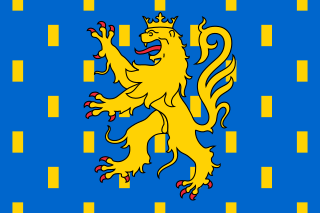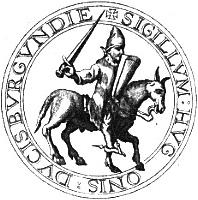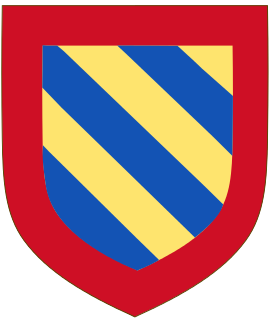This page is based on this
Wikipedia article Text is available under the
CC BY-SA 4.0 license; additional terms may apply.
Images, videos and audio are available under their respective licenses.

Rudolph or Rudolf was the elected King of France from 923 until his death in 936. Prior to his election as king, he was Duke of Burgundy and Count of Troyes from 921. He was the son of Richard, Duke of Burgundy, and Adelaide of Auxerre, and inherited the Duchy of Burgundy from his father. He married Emma of France, daughter of king Robert I of France. He is frequently confused with his uncle Rudolph I of Burgundy.

The Free County of Burgundy was a medieval county of the Holy Roman Empire, within the modern region of Bourgogne-Franche-Comté, whose very name is still reminiscent of the title of its count: Freigraf. It should not be confused with the more westerly Duchy of Burgundy, a fiefdom of Francia since 843.

The Duchy of Burgundy emerged in the 9th century as one of the successors of the ancient Kingdom of the Burgundians, which after its conquest in 532 had formed a constituent part of the Frankish Empire. Upon the 9th-century partitions, the French remnants of the Burgundian kingdom were reduced to a ducal rank by King Robert II of France in 1004, and in 1032 were awarded to his younger son Robert per Salic law – other portions had passed to the Imperial Kingdom of Arles and the County of Burgundy (Franche-Comté).

Richard, Duke of Burgundy (858–921), also known as Richard of Autun or Richard the Justiciar, was Count of Autun from 880 and the first Margrave and Duke of Burgundy. He eventually attained suzerainty over all the counties of Burgundy save Mâcon and by 890 he was referred to as dux (duke) and by 900 as marchio (margrave). By 918 he was being called dux Burgundionem or dux Burgundiae, which probably signified less the existence of a unified Burgundian dukedom than feudal suzerainty over a multiplicity of counties in a specific region.
Henry I, called the Great, was Count of Nevers and Duke of Burgundy from 965 to his death. He is sometimes known as Odo-Henry or Otto-Henry, since his birth name was "Odo" and he only adopted "Henry" on being elected duke of Burgundy.

Eudes II of Burgundy was Duke of Burgundy between 1143 and 1162. Eudes was the eldest son of duke Hugh II and Felicia-Matilda of Mayenne, daughter of Gauthier, Count of Mayenne and Adelina de Presles. He married Marie de Champagne, daughter of Theobald II, Count of Champagne and Matilda of Carinthia.
They had three children:

Hugh III was duke of Burgundy between 1162 and 1192. Hugh was the eldest son of Duke Odo II and Marie, daughter of Theobald II, Count of Champagne.

The House of Burgundy was a cadet branch of the Capetian dynasty, descending from Robert I, Duke of Burgundy, a younger son of Robert II of France. The House ruled the Duchy of Burgundy from 1032–1361.

The Kingdom of Upper Burgundy was a Frankish dominion established in 888 by the Welf king Rudolph I of Burgundy on the territory of former Middle Francia. It grew out of the Carolingian margraviate of Transjurane Burgundy southeast of ('beyond') the Jura Mountains together with the adjacent County of Burgundy (Franche-Comté) in the northwest. The adjective 'upper' refers to its location further up the Rhône river, as distinct from Lower Burgundy and also from the Duchy of Burgundy west of the Saône river. Upper Burgundy was reunited with the Kingdom of Lower Burgundy in 933, and eventually merged into the Imperial Kingdom of Arles (Arelat).

Agnes of France was a Duchess of Burgundy by marriage to Robert II, Duke of Burgundy. She served as regent of Burgundy during the minority of her son in 1306–1311.
The Bosonids were a dynasty of Carolingian era dukes, counts, bishops and knights descended from Boso the Elder. Eventually they married into the Carolingian dynasty and produced kings and an emperor of the Frankish Empire.

John, called the Old (l'Antique), was a French nobleman, the Count of Auxonne and Chalon-sur-Saône in his own right and regent in right of his son, Hugh III, Count of Burgundy. In contemporary documents, he was sometimes called "Count of Burgundy", as by King William of Germany in 1251.
Adelaide of Auxerre or Adelaide of Burgundy can be used interchangeably and may refer to:
Sybilla of Burgundy (1065–1103), was a French noble, Duchess consort of Burgundy by marriage to Eudes I, Duke of Burgundy.

Henry of Burgundy, called the Gallant, was the eldest surviving son and heir of Robert I, Duke of Burgundy, second son of Robert II of France, and his wife, Helie of Semur, granddaughter of Henry I, Duke of Burgundy. Little is known about his life. He died shortly before his father and was never duke himself.










